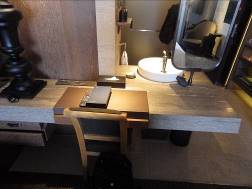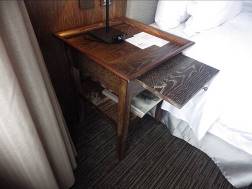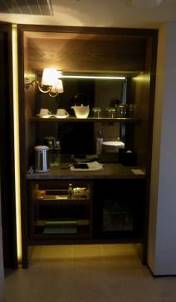Interior Designs of Hotel Rooms Become
Target of Copyright and Competition Issues
The high-end hotel group of Italian origin, LDC Hotels & Resorts (“LDC”), owns several chains in Taiwan including the famous Palais de Chine in the center of the bustling metropolis of Taipei city, and Fleur de Chine situated adjacent to the vast, calm, and romantic Sun Moon Lake. LDC hired a remodeling contractor, October Interior Renovation (“October”), to design its hotel rooms, in which the all-inclusive agreement entailed site planning, space planning, layout improvement, furniture style, sizing and positioning, as well as traffic flow, lighting, etc.
Queena Plaza, another resort group, operated a hotel in Taitung at the southeast coast of Taiwan which was later acquired by the Sheraton group as a franchise and re-branded as Sheraton Taitung Hotel (“Sheraton-Taitung”) in 2016. LDC found out that the later-finished guest rooms of Sheraton-Taitung utilized an overall interior design that was very similar to LDC's. Suspecting copying of architectural concepts, LDC reached out to October to acquire an exclusive license of the copyright for the interior design of guest rooms, and then filed an action against Queena Plaza based on copyright and unfair competition claims. As agreed upon by the two parties, an expert witness submitted a report of assessment presenting the probative similarities between the designs in the guest rooms of the respective two hotels in the dispute, as shown below in Table 1.
LDC first tried to establish the copyrightability of its guest rooms. As the court found, “architectural works” were introduced to the Copyright Act in 1991 as a statutorily recognized work to enjoy copyright protection. An architectural work includes not only a building but an architectural drawing, scale model, and any three-dimensional architectural work built according to either drawings or a scale model, so long as it expresses the ideas and concepts of a three-dimensional structure. An architectural work related to either exterior or interior spaces was supposed to be equally protectable when it met the fundamental requirements of originality and creativity. In summary, LDC’s guest rooms should be subject to copyright protection.
The court reviewed the next issue related to copyright infringement alleged by LDC; however the court denied. To analyze similarities between the accused and protected works, the court applied the test of “comprehensive perception and impression.” When claiming copyright, the owner should enforce the holistic piece of work instead of only a segmented part(s). In review of October’s project plans and drawings, they were not only the guest rooms but the remodeling, spacing, layout making, etc. of the entire hotel. October’s scope of construction included the lobby, conference halls, restaurants, bars, restrooms, and more. Hence, the court was of the opinion to compare the respective entirety of the two hotels. As LDC did not present evidence of originality and creativity of Palais de Chine’s amenities other than the guest rooms, the court has no position to judge similarities of the two architectural works.
Although the copyright was not found infringed, the court upheld LDC’s claim of anticompetition. Article 25 of the Fair Trade Act forbids a “deceptive or obviously unfair conduct that is able to affect trading order” carried out by an enterprise. A particular activity amounts to being “obviously unfair” when the “competitor engages in apparently inequitable conduct including exploiting another’s results of assiduous efforts, plagiarizing another’s webpage built upon industriously collected data, copying in substantive identicalness, etc. [that is] sufficiently considered to impact market order.” Essentially, such an activity becomes reprehensible once it brings about an “abstract risk” to potentially compromise the market order, instead of having to produce an actual impact.
Evidence showed explicitly that some people associated with Queena Plaza stayed in guest rooms at Palais de Chine to take pictures and measure furniture sizes. The images were then re-produced in Sheraton-Taitung, according to the expert witness. The assessment report determined that the two interior designs of selected guest rooms are highly similar to one another as the many arrangements, locations, and relative position of items or furniture pieces were extremely similar. Even the same pattern was used in wallpaper. Sheraton-Taitung rebutted that it was merely commonplace in the area of interior design for some conventional furnishing to be utilized. For example, it is common for a desk set to come with a chair or for there to be a cabinet next to a bed. But the court explained that the witness’ report ruled out such elements of conventional furnishing before making its conclusion. Therefore, the court was persuaded that Queena Plaza conducted in plagiarism.
To determine the loss to LDC resulting from the unfair activity of plagiarism, the court did not employ LDC’s proposed calculation but instead exercised its discretion to award damages. LDC alleged economic injury but was not sufficiently convincing with respect to supporting its damages claim. An average tourist chooses a resort not simply because of the style, furniture, or decoration inside its rooms. Many other factors such as available amenities, food and catering, geographic location, accessibility and shuttling, and the overall quality of all services are taken into consideration with such an average tourist, and these were evaluated by the court. These factors were absent from LDC’s claims. Thus the court in reference to the margin profit standards in the trade of vacation resorts ordered Queena Plaza to pay TWD 5,000,000 plus interest to LDC.
Appeal
Queena Plaza appealed the case. But the appellate court rejected all of Queena Plaza’s arguments, and applied the same opinion as that of the trial court.
Appeal Again
The latest development involved a significant twist. The dissatisfied Queena Plaza unyieldingly raised the appellate decision to the Supreme Court. The Supreme Court vacated the appellate decision and remanded the case back to the appellate court.
The appellate judgement erred, firstly, in sufficiently examining Queena Plaza’s counter argument about the use of conventional furnishing and arrangement, the Supreme Court reasoned. Additionally, the lower courts did not thoroughly investigate whether LDC had a standing to sue. LDC became a licensee only after discovering Queena Plaza’s copying activity. But it was not clear yet if October ever assigned the entitlement to damages to LDC, which enabled LDC a lawful standing to sue. Finally, Queena Plaza persisted that the geographic sites, customer bases, business operations of the two parties in dispute were distinctively different to form no consumption substitution or competition whatsoever. As the interior design of guest rooms bore minor weight for a tourist to choose a resort, even when the lower courts found plagiarism, they did not adequately explain why there were any facts of obvious unfairness severe enough to compromise market order. The lower court decided that the two parties were closely and highly competitive by merely suggesting that Taiwan is geographically small. That was not sufficient to find either obvious unfairness or compromise of market order. The lower court was mistaken in the interpretation of the Fair Trade Act, as the Supreme Court concluded.
This interior design dispute is expected to continue, but a settlement is also well within the realm of possibilities.
Table 1
|
Sheraton-Taitung/ Queena Plaza (Defendant)
|
Palais de Chine/ LDC (Plaintiff)
|
|
|
|
|






|






|
|